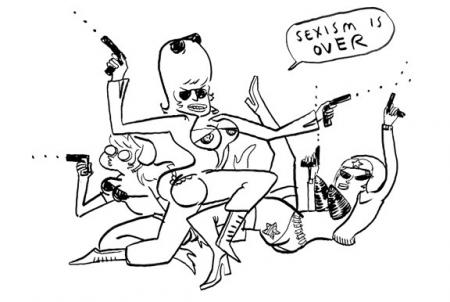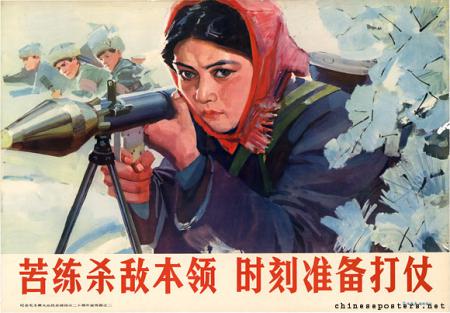Serendip is an independent site partnering with faculty at multiple colleges and universities around the world. Happy exploring!
Critical Feminist Studies Web Paper 4

Violating Language
Sara Gladwin
Critical Feminist Studies Final Paper
Anne Dalke
5/11/12
Violating Language
As I was reading a chapter in the book “Feminism is for Everybody” by Bell Hooks, I became inspired to start thinking about the ways in which language was used in the classroom and what effect changing that dialogue would have on classroom experience. I became interested in exploring how language could be used to alter the classroom to become a more inclusive place, where silenced voices are able to have the opportunity to be heard. Hopefully I could find a way that the classroom could validate students experiences instead of conditioning students to filter out certain parts of their lives from the classroom.

Queering Weakness: The Refusal of Strong Female Characters
Kate Beaton, creator of the webcomic “Hark! A Vagrant”, in collaboration with two other cartoonists, Meredith Gran and Carly Monardo, created a small series of comics called “Strong Female Characters”. In the author’s notes on her site, Beaton comments:
“We are professionals in the entertainment industry and we think we know what we are talking about when we say that there needs to be more strong female characters out there and we know just what to do about it. Finally, some women to look up to!”

TV at the Feminst Table?
Over the past month or so I have been posting regularly about a new HBO program which provoked a lot of public attention, long before it even aired. I was interested in the show, and I was even more interested in what people in our course thought about it. But my “call to discourse” fell flat, so I have decided to take up the project myself. Now my primary interest in the show was not actually the topic, but the fact that the creator/director/writer was a female, liberal arts college graduate and only four years older than I am. Go Girls. I am not sure if it is widely understood how rare this is—look up any of your three favorite television programs, and chances are extremely high, regardless of the topic that the “creator/writer/director” of the pilot episode is male. And if you happen to watch a show conceived by a woman, chances are further likely that she has a male partner/co-creator. Shows about Girls, written by girls, created by girls, and directed by girls simply do not exist. The stories we watch and television every day are stories coming from a definitively male perspective. This is not meant as an inciting, insightful statement. It is nothing but and “is”.

Childbirth
When I began this project I decided I was going to write about the controversy over the cesarean rate in the United States. I have heard nurses and friends talk about the trend of rising rates in cesareans, and from the conversation I’ve realized it’s a very controversial topic. I am interested in women’s health, so I started asking my health care providers what they thought of the c-section rate in the U.S., and I started seeing a trend that people’s view on c-sections often has do with a more general outlook on obstetrics. Many of the people who I came across that didn’t approve in the increasing rate of c-sections had other complaints about how obstetric units are run. People who disproved of the c-section rate often felt that medicine practiced in hospitals is too ‘interventionalist’ and treats birth like there is going to be an abnormality, when in general births are normal. Of the people that told me they didn’t think there was something wrong with the c-section rate, they often had the outlook that giving birth outside of a hospital puts the mother and baby at unnecessary risk of being without a physician. After talking about birth and doing a bit of research I decided I wanted to not only do my paper on c-sections, but also on births in hospitals versus non-hospital births. I interviewed two ob/gyn’s and two certified midwives to try and get their opinions on the matter.

Mulan in Real Life: Chinese Women Soldiers and Feminism
The military has been traditionally defined as a masculine institution; actually it may be the most prototypically masculine one of all social institutions. Therefore, whenever women soldiers appear in public, they seem to be standout since people tend to think that for women to participate, either the military has to be perceived as transform to make it more compatible with how women are, or women have to be perceived as changing in ways that make them more suited for military service. Many changes have occurred in the past several decades. This period has witnessed a mushrooming of attention to women’s contribution to the army. More and more women soldiers are allowed to actually fight on the frontline or engage in violent and dangerous tasks. It seems that society started to recognize female’s ability as protectors of their countries, giving them space to choose whatever they want, including stepping on battlefields. Many people perceive this phenomenon as a huge progress of feminism, while others cast doubts on it. Interested in this issue, I would like to focus on female soldiers, especially Chinese women soldiers, in my webevent.

It's Elementary My Dear Watson
Setting the Scene
In my past web event, I addressed the issue of change specific to the context of a situation. In my case, I looked into homosexuality in the context of Christianity and South Korea. This stemmed from my desire to reframe anti-gay rhetoric at my high school. For my final web event, I want to expand on this idea and investigate what queering education would look like not just at my own school but just on a general level. What does homosexuality look like in schools across the US today and how is affecting students and society? Why should this be addressed? Why is there resistance?
The Other Side
Q Forum Mark 2: CONTINUING THE CONVERSATION (UNDER CONSTRUCTION)
In tandem with Amophrast, Colleen Ryanne, aybala05, and S. Yaeger
Continuing conversations for the year
-After the revamped Q-Forum during Customs Week we will have continuing conversations periodically through the year. These conversations will be open to the entire school, not just first years. There will be three larger conversations, one in the fall and two in the spring.
FIRST CONVERSATION
Working title not yet here: what it means to be queer here and not there
How do we translate a queer space into spaces that we are less comfortable in/feel less safe in/etc.?
The first post-Customs Week Q Forum discussion, it will cover issues such as coming out, the idea of being out and all that entails, and talking with people from home/family about queer life at Bryn Mawr. This conversation will take place the week before Fall Break by hall, and will be open to anyone. There will most likely be follow up events hosted by Rainbow Alliance during Out Week (week we get back from Fall Break).
Theoretical Hosts: HA's and CDAs

Sex and Work: Japanese Host Clubs and Hentai into Context
The week that our class discussed sex work was definitely the most intriguing and insightful classes we’ve had this semester. A lot of the discussion revolved around the idea of porn and watching porn. Dchin expressed discomfort while watching the documentary Live Nude Girls Unite! because of specific details while the girls at The Lusty Lady were stripping. It wasn’t exactly the blatant nudity that bothered her, but the scene where one of the customers is watching the stripper strip. She said, “It didn't strike me as odd while watching the film that I wasn't uncomfortable seeing the women's naked bodies but instead uncomfortable watching one of the male patrons watching the women dance.” She explains why saying that it made her feel like she could easily be in the position of the stripper and the power of the gaze would be too invasive for her. She couldn’t imagine being the same place as the stripper and being watched in such an intrusive manner.

Setting the framework for further work with the BMC Community regarding gender on campus
Over the past year, I've been working across several classes and with several other students, as well as some people out in the world, to try to improve the way we handle gender on campus.
This project started with a post on tumblr from a young trans woman who was very angry at the idea of trans women being excluded from a women's space.
At first, I and a few other mawters reacted defensively, but then I started thinking about gender on campus and all the ways we don't talk about it effectively.
I started a conversation with her on serendip, wherein we discussed some of the problems of a Women's College in a post binary world. (Post binary in the sense that not everyone identifies on the binary)
At the same time, Aybala was doing her work within the administration of attempting to determine the potential of admitting transwomen into the college. She's already provided a link to that work in her post here.
Recently, and with a lot of help along by this class, I have begun to think about how the BMC community exists in several places at once.
We are defined by the admistration as a space for women, women here presumably meaning people with vaginae, but we are not all women, and not all women are admitted here.



